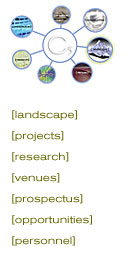 |
Post-space
![]()
Anne-Marie Schleiner
"The archivization produces as much as it records the event...this means that, in the past
psychoanalysis would not have been what it was (any more than so many other things) if E-mail,
for example had existed."
The recent assignment C5 agreed to undertake was to translate data already generated in a physical
space and recorded into a "virtual reality" archive to the "space" three times removed of Internet.
The identity shifts in the ontology of the datum as it migrates from museum space (Joel Slayton's
installation of To Not See a Thing) to a 3d Cartesian digital grid on a single Silicon
Graphics computer to network space posed the initial point of inquiry for 16 Sessions.
Or, perhaps to speak in terms of "space" is misguided, to label the abstracted x,y,z grid of a
"Virtual Reality" simulation a space seems somewhat appropriate, but to describe the fractured
"elsewhere" of the Internet, the overlapping windows and planes of text, 2-d and 3-d images,
interconnecting and communicating chains of information bodies and datum as "cyberspace" is to
succumb to the frontier narratives of the techno-evangelists of the information era whose use of
metaphors such as "information superhighway" and "electronic frontier" recall the myths of
colonialism and manifest destiny that motivated expansion into the American West (in this case the
natives are conveniently absent.)
16 Sessions does not attempt to insert a pin into the butterfly, to fixate an essential
system identity onto the polymorphous, multivalent Internet, but C5, (along with other researchers
in the fields of Data Mining and Systems Theory), is engaged in the project of formulating visions
of network data topologies that offer alternatives to notions of the Internet as frontier space or
even accepted notions of hypertext. 16 Sessions is conceived as a data topology (from
"topos" with the emphasis on placement rather than space) whose system identity drifts into new
data relations as IP addresses and pre-formed data patterns mingle with one another. Thus, the
method of data archive, the Internet in this case, bleeds into the very "nature" of the data,
effecting a profound shift that forever alters the data ontology.
16 Sessions operates as art in an art discourse domain informed by systems theory and
post-modern theories of cyberculture. 16 Sessions is also another C5 endeavor applicable
as research and intellectual property in the corporate realm of techno-capitalism, a hybrid art
that reaches outside the art world and participates as a player in technocultural developments.
At the edge of the millennium, C5 is breathing the same giddy air as techno-cultic Gnostics such
as the Extropians and Heaven's Gate group, collectively (but perhaps more healthily so) taking the
dizzying step into disembodied knowledge techno-spheres and very happy to find ourselves here.
-Jaques Derrida, Archive Fever, 1995
Bibliography
Davis, Eric. Techgnosis-Myth, Magic and Mysticism in the Age of Information.
New York: Harmony Books, 1998.Derrida, Jaques. Archive Fever-A Freudian Impression.
Chicago: The University of Chicago Press, 1995.Morse, Margaret. Virtualities-Television, Media Art, and Cyberculture.
Indiana: Indiana University Press, 1998.